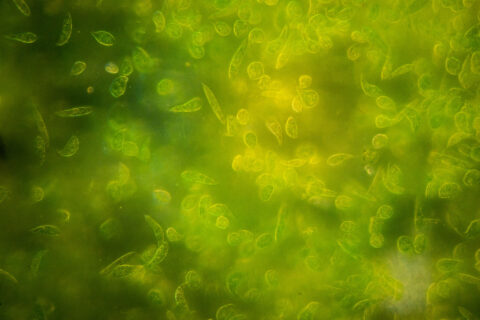Tapping into the hidden potential of algae
FAU biologists involved in a global consortium to investigate the biotechnological potential of algae species
Whether it is as a new organic fuel, innovative cancer medication or a sustainable source of food: researchers across the globe see immense potential in euglenoids. Of the 1,000 known species, only 20 have been investigated to date. The Euglena International Network (EIN) now hopes to change this situation. FAU researchers are also on board.
Science is strangely fascinated by euglenoids: the diverse single-celled organisms, many of which are delicately beautiful and shimmer in various shades of green, can be found in an unusually wide range of ecosystems throughout the world. They feature a combination of animal and plant characteristics. The most well-known species is Euglena.
In order to make the most of the enormous potential afforded by euglenoids, however, researchers must find out more about the gene structure of the species as well as the fundamental biology and evolution of euglenoids. Until now, fewer than 20 species have had their gene sequence investigated, as determining their DNA is a particularly complicated process.
The Euglena International Network (EIN) brings together hundreds of researchers from across the globe with the shared goal of furthering research into euglenoids. Their ambitious plan is to sequence the genome of all known euglenoid species within the next decade. FAU belongs to the global consortium
Dr. Michael Lebert, lecturer at the Chair of Microbiology at FAU and an expert, among others, in Euglena gracilis, is optimistic about the initiative’s chances of success. “In past years, the commercial use of euglena has been very strongly encouraged, particularly in Japan. The combination of fundamental and applied research coupled with commitment from industry will have a particularly positive effect on encouraging research into microalgae in general and Euglena in particular.”
In the past, Lebert has already worked extensively with the species Euglena gracilis, and he and his team have constructed a self-sustaining system for growing plants, for example under conditions such as those in space, in which the Euglena species plays a significant role.
In a position paper in the journal Biology Open, the EIN outlines the importance of developing a concerted approach for generating a high quality reference genome for the nearly 1,000 known species of euglenoids.
The data gathered by the EIN will be made freely available to the scientific community via the European Nucleotide Archive (ENA).
Further information
PD Dr. Michael Lebert
Chair of Microbiology
michael.lebert@fau.de
